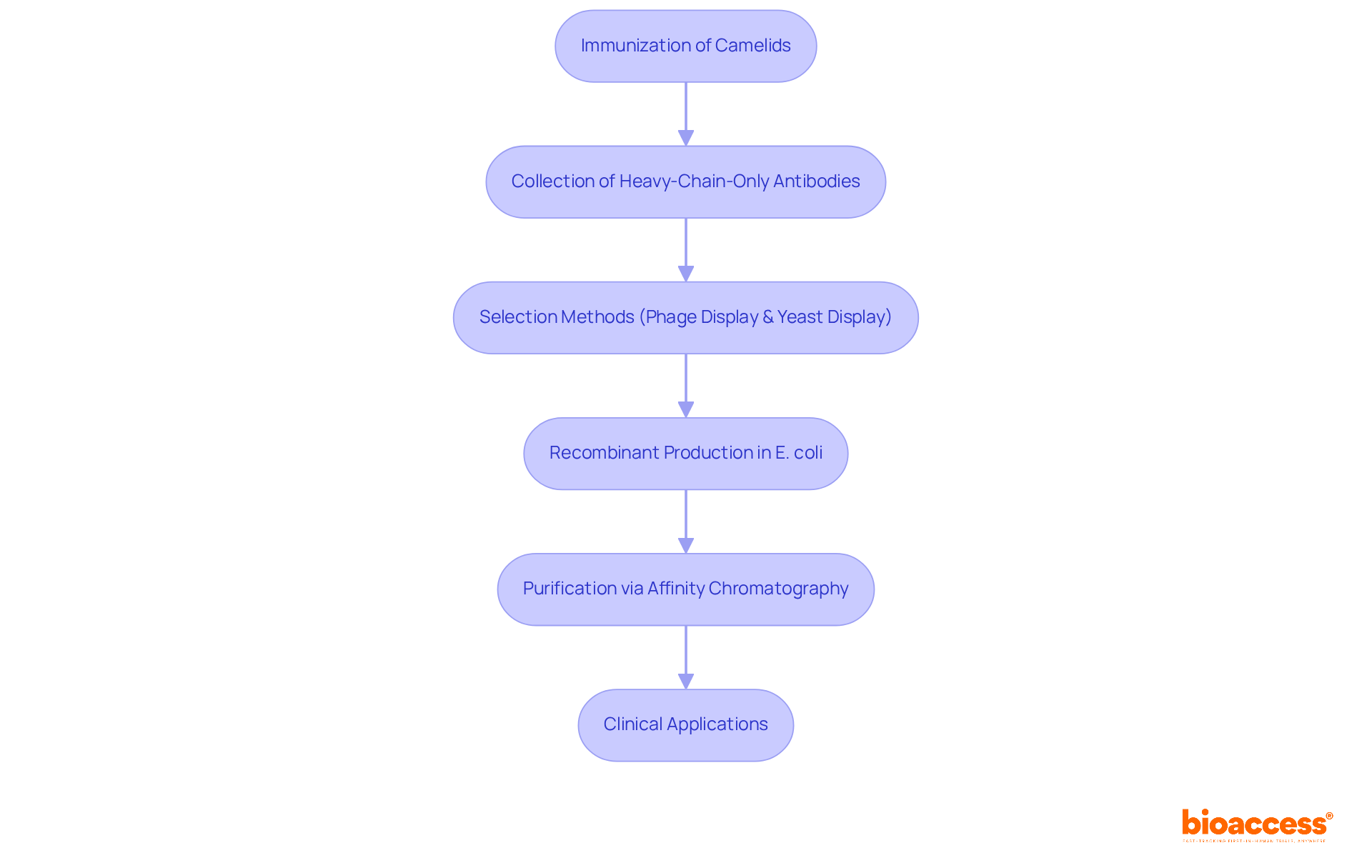


Nanobodies, a remarkable class of single-domain proteins derived from camelids, are transforming the fields of diagnostics and therapeutics. Their unique structure provides exceptional binding capabilities, allowing them to target hidden antigens that traditional antibodies often struggle to reach. As the potential applications of nanobodies continue to expand, it is crucial to ask: what precisely defines a nanobody, and how do its distinctive features open new avenues in medical science? Understanding these aspects is vital for advancing clinical research and addressing the challenges faced in the Medtech landscape.
To understand what is a nanobody, it is important to know that they are also known as single-domain proteins (sdAbs) and are derived from the heavy-chain-only immunoglobulins found in camelids, such as llamas and alpacas. These proteins consist of a single monomeric variable domain, typically weighing around 12-15 kDa, which allows for specific binding to target molecules. Unlike traditional immune proteins that include both heavy and light chains, nanobodies are devoid of the light chain, resulting in a simpler and more stable structure. This unique configuration not only enhances their solubility but also facilitates superior tissue penetration and the ability to bind to hidden or recessed epitopes on antigens. Such characteristics raise the question of what is a nanobody and why they are particularly valuable in medical and diagnostic applications.

What is a nanobody that makes it stand out due to its unique structural characteristics, setting it apart from traditional immune proteins? Their small size facilitates rapid diffusion and deep tissue penetration, making them particularly advantageous in imaging and therapeutic contexts. Additionally, the convex form of these small antibodies enables them to attach to concave areas of targets, often inaccessible to larger antibodies. The extended complementarity-determining region 3 (CDR3) of these molecules significantly contributes to their high affinity and specificity for target antigens.
Moreover, nanobodies exhibit remarkable stability under extreme conditions, such as high temperatures and varying pH levels. This inherent stability broadens their applicability across various fields, including diagnostics and drug delivery systems. As the Medtech landscape evolves, it is crucial to explore what is a nanobody in addressing key challenges. Their unique properties not only enhance therapeutic efficacy but also pave the way for innovative solutions in clinical research.

In the field of clinical research, one might ask what is a nanobody, given that they have emerged as powerful tools in both diagnostics and treatment. In diagnostics, they serve as highly specific imaging agents, enabling the visualization of disease processes at the molecular level. For instance, small antibody fragments can be labeled with radioactive isotopes for use in PET and SPECT imaging, which provides high-resolution images of tumors and other abnormalities.
In the realm of medicine, small antibodies are being developed as targeted therapies for various illnesses, including cancer and autoimmune conditions. Their unique ability to penetrate tissues and bind specifically to antigens allows for targeted drug delivery, which minimizes side effects and enhances treatment efficacy. Furthermore, these small antibodies can be designed to deliver therapeutic agents directly to affected cells, significantly improving the accuracy of treatments.
The integration of nanobodies into clinical practice not only showcases their versatility but also emphasizes what is a nanobody in addressing key challenges in healthcare. As we continue to explore their potential, collaboration among researchers, clinicians, and industry leaders will be essential in advancing these promising therapies.

In clinical research, what is a nanobody generation process that begins with the immunization of camelids, which produce unique heavy-chain-only antibodies? This innovative approach leads to a diverse collection of small proteins, utilizing methods such as phage display and yeast display. These techniques are crucial for selecting high-affinity binders tailored to specific antigens, which helps in understanding what is a nanobody and ensuring its effectiveness.
Once promising candidates are identified, they are produced recombinantly in microbial systems like E. coli, facilitating large-scale production. The purification of these nanoparticles typically employs affinity chromatography, which guarantees high purity and functionality of the final product. Recent advancements in synthetic biology and computational design are significantly enhancing the efficiency and specificity of nanobody generation, which raises the question of what is a nanobody and paves the way for their expanded application in biomedicine.
For instance, the integrated screening method has achieved a remarkable throughput of approximately 10 per 96-well plate, greatly increasing the efficiency of nanobody discovery. Additionally, phage display technology has proven effective in enriching antigen-specific clones, streamlining the development process. Notably, the probability of certain positive clones was around 1‰, underscoring the effectiveness of the screening process.
Furthermore, the entire nanobody production process can be completed in just 8-9 days following the generation of an immune response, showcasing the rapidity of this method. Caplacizumab, what is a nanobody that is the first anticipated to gain clinical approval, exemplifies the practical applications of these small antibodies in clinical settings. These innovations not only enhance the production pipeline but also broaden the potential uses of nanobodies in therapeutic and diagnostic applications, prompting the inquiry of what is a nanobody.

Nanobodies signify a remarkable leap in biotechnology, presenting distinct structural and functional benefits compared to traditional antibodies. Originating from camelid heavy-chain-only immunoglobulins, these single-domain proteins are not only compact but also exhibit exceptional stability. This unique configuration allows them to effectively penetrate tissues and bind to specific antigens with high affinity, enhancing their solubility and establishing them as essential tools in diagnostics and therapeutics.
The versatility of nanobodies across various applications is noteworthy. They serve as precise imaging agents in diagnostics and hold promise as targeted therapies for complex diseases. Their unique properties pave the way for innovative solutions in clinical settings. Moreover, the processes involved in their generation and production, such as phage display and recombinant expression, highlight their significance, enabling rapid and efficient development.
Exploring nanobodies opens new horizons in medical research and treatment. As healthcare continues to evolve, leveraging the potential of nanobodies could lead to significant breakthroughs in disease management and patient care. It is imperative for researchers, clinicians, and industry leaders to collaborate and innovate, ensuring that these remarkable proteins are fully realized in their applications. This collaboration will ultimately transform the future of medicine.
What are nanobodies?
Nanobodies, also known as single-domain proteins (sdAbs), are derived from the heavy-chain-only immunoglobulins found in camelids, such as llamas and alpacas.
What is the structure of nanobodies?
Nanobodies consist of a single monomeric variable domain, typically weighing around 12-15 kDa, and are devoid of light chains, resulting in a simpler and more stable structure.
How do nanobodies differ from traditional immune proteins?
Unlike traditional immune proteins that include both heavy and light chains, nanobodies only have a heavy chain, which contributes to their unique characteristics.
What advantages do nanobodies offer in terms of solubility and tissue penetration?
The unique configuration of nanobodies enhances their solubility and facilitates superior tissue penetration, allowing them to bind to hidden or recessed epitopes on antigens.
Why are nanobodies valuable in medical and diagnostic applications?
Their ability to specifically bind to target molecules and their unique structural properties make nanobodies particularly useful in various medical and diagnostic applications.